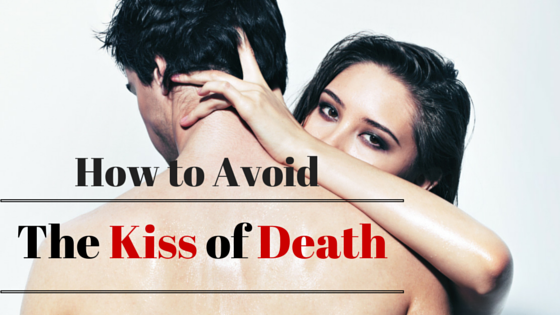Brand Strategy: Stand Out or Face the Kiss of Death [Template]
A Tale of the Client “Kiss of Death”
You’ve had your eye on this client for years…
You’ve been talking with them for months…
They’ve been “reviewing your proposal” for weeks…
You finally come in to present and it takes hours…
The prospect is about to make their final decision in a matter of minutes…
But before they choose they say, “We’ve seen all of your materials. We understand everything in your proposal. We just have one last question. Your competitor has a very similar scope of work for 25% less. Are you able to match that amount?”
WHAT?
How did you get here? Is this the Twilight Zone? Are you being Punk’d?
They know what you charge. You told them more than once. You’ve even put it on paper and they said, “okay”. And now, at the very end of the conversation, you are being asked to do the full scope of work for less than full price.
They lured you in with the hopes of new business only to introduce you to the positioning "Kiss of Death". Now you know how they really feel about you. Sound familiar?
About This Guide
This guide is for consultants and other premium service providers who believe in the value of positioning and the influence it has in attracting (and retaining) high value clients. It is designed to help you establish a clear point-of-view up front so your client knows who you are, what you do, and the value it has to them.
This guide assumes you know premium positioning doesn’t come automatically or by way of fancy taglines. True positioning is only respected by clients after a company is reflective enough to discover it, courageous enough to share it, and disciplined enough to refine it...until everything feels just right.
Don't get confused...
This conversation goes by a number of different names…strategic positioning, positioning, being unique, differentiation, standing out, branding, brand story, brand message, brand authority, building a brand, brand strategy, finding your voice, voice and tone, knowing your why, having a purpose, and the list goes on…
To make this guide easy to read (and the instructions easy to follow) I am bundling ALL of these terms together and expressing them through two core positioning statements. Why? Because simpler is better. No one wants to hear your long story until you have impressed them with your short one.
This is a guide to help you clarify your marketplace positioning and share it in a way that is compelling for others to hear.
In a hurry? Download the step-by-step positioning templates now
--> download the templates
Now, back to the story…
Why did this prospective client wait until the very end to bring up the 25% discount?
They invited a bunch of firms to submit proposals. They reviewed them all and compared them to each other. As far as they can tell, everyone is "pretty much saying the same thing", but one company is charging about 25% less than the average.
Still, they liked you because of your charm, wit, and professionalism. They would prefer to work with you, but now they know they can get the "same thing" at a discount. And since there is no "real" difference between what you and your competitors DO they figured they would ask you to lower your price to match the competition.
...and this is the positioning Kiss of Death.
Kiss of Death: You and Your Competition Are Twins
When this situation happens it’s demoralizing. After all, you’ve gone through so much effort to make it clear that your company is different.
Yes, you spent thousands of dollars on a fancy website.
Yes, you and your team have some of the best training and experience around.
Yes, you have a burning desire to help your clients achieve amazing things.
But when it comes down to it you and your competition look way too much alike. You walk, talk, and (if you are honest) THINK waaaaay too much alike.
Your prospective client simply cannot tell you apart.
That’s why you can’t win more business. That’s why you can’t charge premium pricing.
As far as the client is concerned, they can line up the top 5 competitors, pick one at random, and get the same experience.
It really doesn’t matter to your client if they work with you or a competitor. You and your competition are all the same.
You and your competition are like twins. Like Tiki and Ronde Barber.
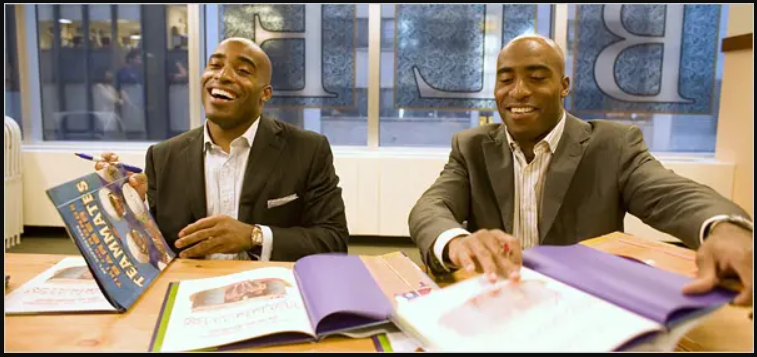
Tikeand Ronde Barber book signing. Photo credit: https://www.nytimes.com/2006/10/25/sports/football/25barber.html
You might look alike, but you definitely are NOT the same
Tiki and and Ronde are not the same person. Do they look alike? Yes. Are they the same? No.
How can we tell them apart? They have the same parents. They have same hometown. They have the same undergraduate education. They even have the same profession!
But if you were going to hire Tiki or Ronde Barber, you are not hiring them according to how they look. You are hiring them according to what they DO. And they DO two different things.
Proof: Both Tiki and Ronde played in the NFL.
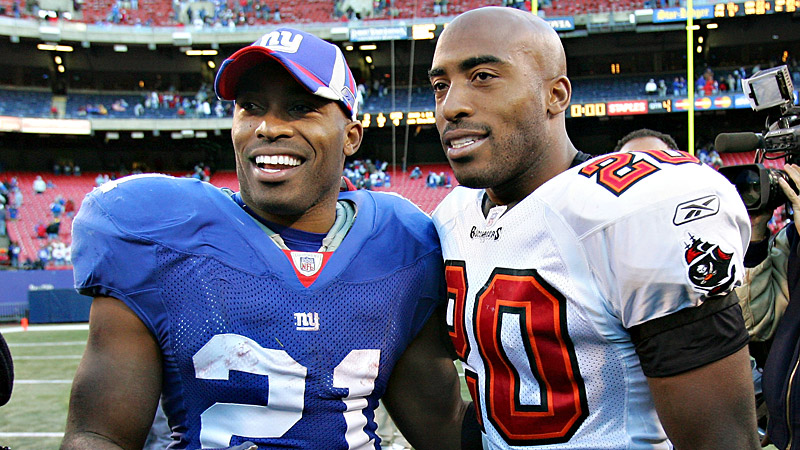
Tiki and Ronde Barber. Photo credit - ESPN Best Sports Twins http://es.pn/1HdIFKl
Tiki Barber’s Career NFL Stats
New York Giants (Blue Jersey)
Position: Running Back
Carries: 2,217
Yards: 10,449
Yards Per Carry: 4.7
Touchdowns: 55
Ronde Barber’s Career NFL Stats
Tampa Bay Buccaneers (White Jersey)
Position: Cornerback
Tackles: 1005
Sacks: 28
Forced Fumbles: 13
Interceptions: 47
Even if you understand very little about American football, you will notice that Tiki is an offensive player. Ronde is a defensive player.
Are you starting to see it?
If you are looking to score more points you call Tiki.
If you are looking to stop the other team from scoring points you call Ronde.
Their approach to the game, their thought process, and the results they create are very different.
They DO two very different things. Therefore their positioning is completely different from each other.
More examples of “look alike, but not the same”
Let’s take a second and really drive this home, because even in the most competitive landscapes there are competitors that look very much alike, but are not the same.
McDonald’s and Burger King look alike, but are not the same.
Nike and Reebok look alike, but are not the same.
Microsoft and Apple look alike, but are not the same.
Toyota and Honda look alike, but are not the same.
The Temptations and The Four Tops look alike, but are not the same.
N’Sync and the Backstreet Boys look alike, but are not the same.
Garth Brooks and George Strait look alike, but are not the same.
Usher and Michael Jackson look alike, but are not the same.
English and Spanish look alike, but are not the same.
Cabbage and lettuce look alike, but are not the same.
How is your BEST client supposed to know the difference?
No matter how similar you may look to your client’s other options, the only way you are going to establish any real difference is to do two things. First, you must claim (and explain) the position you choose to play in the industry. Second, you must claim (and explain) the results you expect your clients to experience.
This comes down to creating (and owning) some very specific positioning statements.
You can cheat this process, but you will lose.
Yes, you can “make something up”.
Yes, you can “copy” what you see a competitor doing.
Yes, you can “sell harder” with more personal energy and charisma.
But each is just a way to compensate for the fact that you really aren’t sure what makes your company different.
Most (conventional) consulting companies take a “WE are the best” type of position. For example:
- WE are honest.
- WE are number #1 in customer service.
- WE have friendly people.
- WE care about our clients.
- WE are experts.
It’s “boring”. It’s “generic”. It’s “much of the same”. Most importantly, your BEST client can’t figure out what you are going to DO for them. Therefore, they just assume that you will do whatever the last guy did (or didn’t) do.
Note: Never let your positioning be determined by the last guy. It rarely works out well.
Right up front, make it clear that you intend to play the game differently.
The work you do matters. There is a reason why you do it. There is a certain result you expect your client to experience. And there is a reason they should choose you.
These aren’t questions you should wait for your client to ask. It matters too much and your client may not know to ask. (Remember you are the expert, you know what matters most.)
Instead, hit them right up front with your statements of value.
Promise a unique experience guaranteed to change their situation
Everyone has a story. You have a story about why you chose to lead your business. Your client has a story about their current struggle and how bad they want it resolved.
Combine these stories. Make them one. Creating conversations around each side’s unique story allows you and your client to connect on a much deeper level.
There are two statements you are going to need.
Now, let’s layer this in because it can be a lot to communicate if you are new to it. It can also be a lot for your BEST client to hear if they are new to it.
The easiest way to ease into this conversation is to describe your business in terms of a simple before and after.
For example:
#1 QUICK INTRO TEMPLATE:
"My company’s name is [name]. We transform a [bad situation] into a [good situation]."
EXAMPLES:
"My company’s name is StrongestMan Fitness. We transform weary, middle-age men into youthful, spry athletes."
"My company’s name is Count Right Accounting. We transform dreadful, error-filled accounting statements into trustworthy, decision-making documents."
My company’s name is HireFast HR Consultants. We transform lengthy, inefficient hiring methods into laser-focused hiring machines.
While a single sentence may convey the overarching direction of your business, you may also need to develop an elevator pitch to provide more context. This allows your prospect to better appreciate the story your business is telling in addition to providing a couple of “seeds” that can grow into later conversation.
Here is a templated approach to help you sharpen your positioning.
First determine answers to the following questions and then compile the answers in the template given below:
-
(Name of your business)
-
(A) What primary market do you serve? Identify the broadest market descriptor. i.e. “Fitness”, “Accounting” “Human Resources”, “Manufacturing” .
-
(B) For whom does the business exist? What broad category of target user are you targeting? i.e. “For (individuals, startups, SME businesses, corporate enterprises, Government Departments, Non-profit organisations, Government Agencies …”
-
(C) What are their burning problems that your offer solves? i.e. They “ can no longer afford …", “are tired of ….”, “want safer ….”, “need better performing ….”, "desire a better looking …..”, “need a more comfortable ……”, “are looking for a longer lasting ….”, “want the latest ……”, “need to reduce the costs of …..”, “want a more convenient ……”, “need an easier to use …..”, "want to indulge ..." or “want improved access to ….”.
-
(D) What specific service do you provide that satisfies this burning problem? e.g. “full body training programs”, “done-for-you accounting services”, “outsourced human resource department”
-
(E) Who is the service primarily targeted to? Who gets the most value from your services? i.e. middle aged men 35-50, small businesses with less than 5 million in revenue, manufacturing companies with over 100 employees.
-
(F) How do the primary target users benefit? What’s in it for them? Identify the tangible or subjective benefits. i.e. To “mitigate fear”, “improve their self esteem”, “gain increase confidence”, “improve their status”, “gain greater meaning”, "satisfy an urgent demand”, “find pain relief”, "save time/money" or “grant an indulgence”.
-
(G) Where else have customers previously gone to satisfy their burning problems? What type of business is your main competitor for the primary target user? i.e. big corporations, solo operators, custom made specialists, supermarkets, mass producers ...
-
(H) Why is your service offer different/better from other options? “Unlike …..“or "as opposed to …. (existing offers)" who don’t do something or are very expensive or are unsafe or are not attractive or are outdated or are too slow or don't value something or hard to access or difficult to use.
Put your answers in this template below. Say it out loud and keep refining it until it can be delivered seamlessly and authentically:
CONVERSATION CREATION TEMPLATE:
[Business Name] specializes in providing [A] for [B] who want [C] offer. Our [D] helps [E] accomplish [F] unlike [G] who are [H].
EXAMPLES
Positioning statement for a fictional accounting company called Count Right Accounting:
Count Right Accounting specializes in providing (A) accounting for (B) San Antonio based small businesses who want (C) better financial reporting. Our (D) done-for-you accounting services help (E) executive teams (F) make better financial decisions unlike (G) self-managed accounting services that (H) appear easy to use but create mistakes for those not familiar with advanced accounting.
Fictional health and wellness company called Strongest Man Fitness:
Strongest Man Fitness specializes in providing (A) health and wellness programs for (B) individuals who want (C) to return to full athleticism. Our (D) personalized 6-week bootcamps help (E) middle-aged, corporate men (F) restore strength, power, and movement unlike (G) local fitness gyms that (H) have a lot of equipment, but do not focus on the corporate athlete who sits for the majority of the day.
What does this look like in the “real world”?
What does it look like when a business fully commits to it's positioning?
Here are four examples to serve as inspiration. There is no magic here, just a sincere commitment to never be confused with a competitor ever again.
Barfield, Murphy, Shank & Smith CPA - Certified Public Accountants
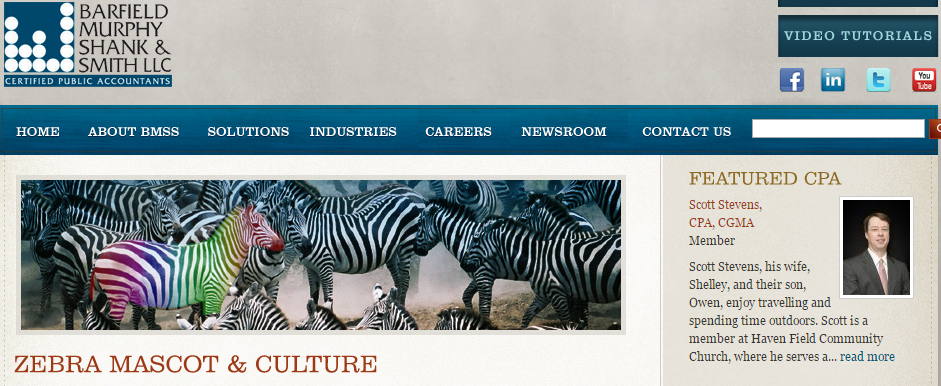
Website: http://www.bmss.com/zebra.php
Positioning in Action: First of all, this CPA firm has a mascot. Second of all, their mascot is a multi-colored Zebra. It's their way of representing their unique, bright and colorful culture. Maybe your reaction is, "Sure anyone can say that". Okay, well what if they made a rap video about their company culture? Is that "living it out" or what?
-
Wistia
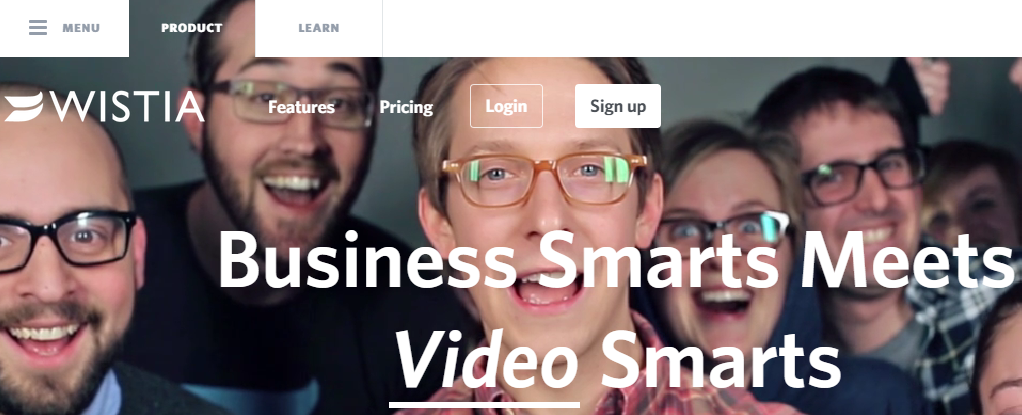
Website: http://wistia.com
Positioning in Action: Their homepage implies that they live at the intersection of "business smarts" and "video smarts." It doesn't take long to see that they mean it. Their video hosting service is straightforward, easy to use, and provides plenty of insights on how your videos are being consumed. That's the video part. Their website contains a blog and community to help businesses at different stages understand and use video from a variety of angles. That's the business part. They are getting it right over there.
-
Hi Oscar

Website: https://www.hioscar.com/
Positioning in Action: We know that conversations about healthcare coverage can be confusing and intimidating. Hi Oscar says, "We’re using technology and design to make healthcare simple, intuitive, and human." It sure feels that way. Their website is NOT an endless encyclopedia of medical data to dig though. Instead, it feels more like a guided tour by a human. Furthermore, they are able to keep their service level high because they focus tightly on a geographic market (New York City). They are not trying to be everything to everyone. That specialization keeps them special.
Example: Yoh
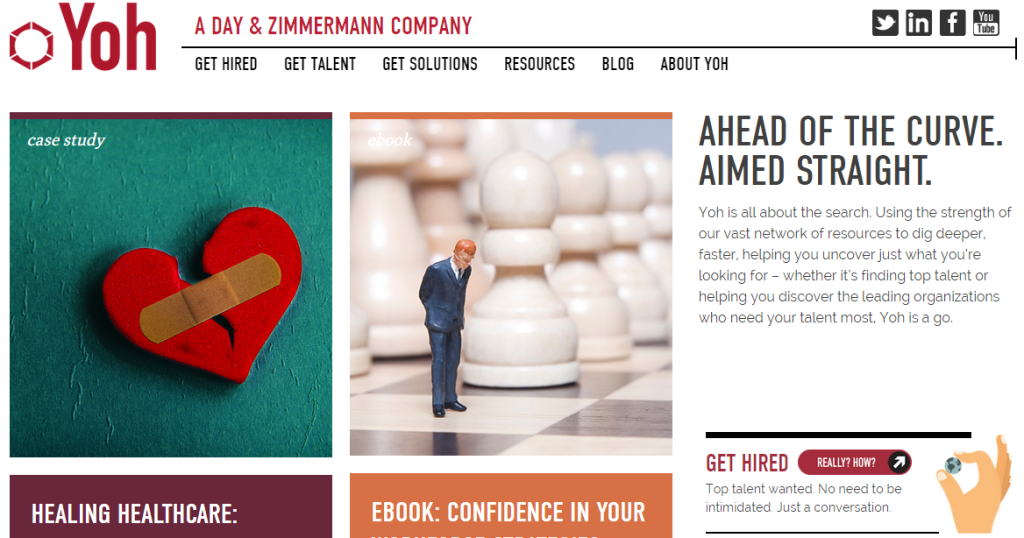
Website: http://www.yoh.com/
Positioning in Action: If you've ever worked with a recruiting company, you know they can be a stuffy bunch. Everything feels very corporate and formal. Yoh does not feel that way. The content on the site is brought to life with strong visuals (versus typical industry jargon). This specific difference in positioning does two things. One, the client will understand (and appreciate) more about the placement process before signing on for services. Two, it is an excellent way to relate to prospective clients and show that Yoh understands their needs. For example, listen to their VP of Marketing sing "Losing My Commission" to honor the challenges of commission based sales people.
What results can you expect if you commit to your positioning?
Remember we agreed at the beginning of this guide that positioning doesn’t come automatically or by way of fancy taglines. True positioning is only respected by clients after a company is reflective enough to discover it, courageous enough to share it, and disciplined enough to refine it...until everything feels just right.
If you do the work, your positioning in the market will change. Here are three things I know will happen.
One, your competition is not going to do this. It’s just too hard. It’s too scary to admit where you are best, promise excellence, and allow clients to hold you accountable to that excellence. It’s so much easier (and less scary) to “see what’s selling”, copy that, and hope for the best. Those that DO this will eat those that DON'T do this for breakfast.
Two, your confidence will change your deal flow. When you know what makes your company unique AND you know how to express it (cleanly), things change. You stop apologizing for charging more than what your client “thought it would cost”. You stop giving your time away to prospects who do not fit your services best. You stop offering the services that are not in line with what you promised. You ask for better deals and you get better deals.
Three, you will get frustrated before you get finished. What a buzzkill right? This was too good of a read to end with a promise of frustration. Unfortunately, this is the part most skip over. Yes, this guide gives you tools, but this is a process that takes time, iteration, and refinement. At some point you will be "over it" and you'll want to revert back to old habits. Don't do it. If the promise of frustration doesn't scare you...and you push through...you will finish. And when you finish, no one will hold a candle to the uniqueness you've carved out in the market.

That was fun, wasn't it? Go ahead and download the step-by-step templates now.
You might be surprised what you discover about your own marketplace positioning. --> download the templates
Thanks so much for reading. What is the one thing your BEST client should know about you? Post it in the comments below.

